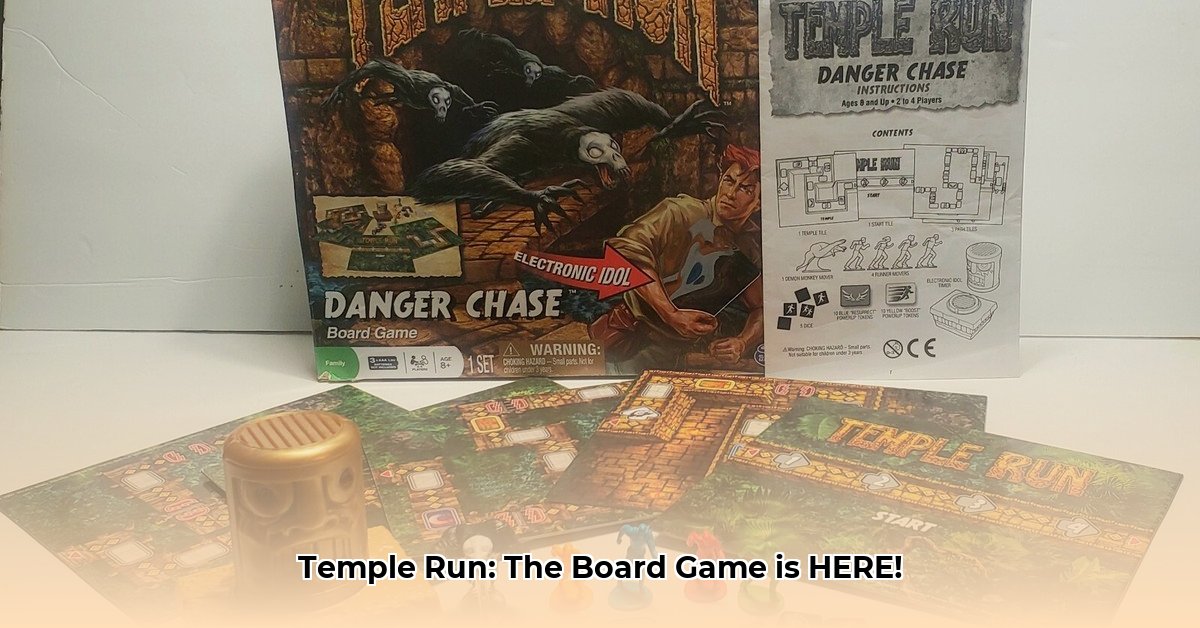
Top 5 Temple Run-Style Board Games: A Thrilling Race Through History (and the Jungle!)
The exhilarating rush of escape, the nail-biting near-misses—Temple Run-style board games capture the frantic fun of the popular app, adding the tactile satisfaction of a physical game. But with a growing market, choosing can be tough. This list highlights the best options for 2024, focusing on gameplay, theme, replayability, and overall fun. Each game offers a unique experience, ensuring there's a perfect match for your game night.
Jungle Chase:
Game Overview: A fast-paced, family-friendly game (2-4 players, ages 8+) where players race through a jungle temple, dodging traps and collecting artifacts. Simple rules make it ideal for younger players or newcomers to board games.
Pros: Easy to learn and play; consistently exciting gameplay; great for multi-generational game nights.
Cons: May become repetitive after multiple playthroughs; the excitement level could plateau with repeated games.
Where to Buy: [Insert Link Here]
Rating: 4 out of 5 stars
Temple Raiders:
Game Overview: A more strategic experience (2-6 players, ages 10+) involving navigating hidden paths, solving puzzles, and outsmarting opponents. Offers more complexity and a higher reward for skilled players.
Pros: Offers strategic depth; highly replayable due to varied strategies; immersive theme.
Cons: Longer learning curve compared to Jungle Chase; game sessions can be lengthy.
Where to Buy: [Insert Link Here]
Rating: 4.5 out of 5 stars
Run for Your Lives!:
Game Overview: A unique cooperative game (1-4 players, ages 7+) where players work together to escape a collapsing temple. Focuses on teamwork and collaboration rather than competition.
Pros: Offers a collaborative experience; creates memorable shared moments; provides a fresh perspective on the Temple Run concept.
Cons: Cooperative gameplay might not appeal to all players; less suitable for those who prefer solo play or cutthroat competition.
Where to Buy: [Insert Link Here]
Rating: 4 out of 5 stars
Hidden Temple:
Game Overview: A game of deduction (2-4 players, ages 12+) where players search for hidden treasures while secretly avoiding each other. The ever-changing board ensures high replayability.
Pros: Highly replayable due to unpredictable gameplay; offers tense, strategic gameplay.
Cons: Intense competition might be overwhelming for younger players or those who prefer less cutthroat games.
Where to Buy: [Insert Link Here]
Rating: 4.5 out of 5 stars
Escape the Curse:
Game Overview: A simple, fun game (1-4 players, ages 8+) perfect for casual gamers and family game nights. Features quick setup and easy-to-learn rules.
Pros: Simple rules; fast setup time; highly accessible for casual gamers and families.
Cons: Higher reliance on luck compared to strategy-focused games.
Where to Buy: [Insert Link Here]
Rating: 3.5 out of 5 stars
The Temple Run Board Game Market: Navigating the Rapids
The Temple Run board game market is dynamic. While some games become instant hits, others fade quickly. What separates the successes from the failures? Innovation is key. Simple rules alone aren't enough; a successful game needs a unique selling point—a strategic twist, a captivating theme, or exceptional components. Is there a secret formula for success? The data suggests that a compelling blend of engaging theme, intuitive mechanics, and high-quality components correlates with positive player reception and increased market longevity.
| Feature | Successful Games | Unsuccessful Games |
|---|---|---|
| Gameplay | Clever, uncluttered mechanics | Repetitive actions, excessive complexity |
| Theme | Engaging stories, high-quality visuals & components | Generic themes, poor-quality components |
| Overall Experience | Fun, engaging, memorable | Forgettable, un-stimulating |
The market, while competitive, remains ripe for innovative games. The future likely holds more cooperative games and titles incorporating more complex strategic elements, creating an exciting landscape for players and designers alike.
Designing Your Own Temple Run Board Game: A Step-by-Step Guide
Creating a profitable Temple Run-style board game requires a strategic approach. Consider these steps:
- Concept Development: Define the core concept and unique selling proposition (USP).
- Gameplay Mechanics: Design intuitive mechanics that allow players to navigate the "temple" using dice, cards, or a combination.
- Obstacle Design: Create increasingly challenging obstacles to enhance replayability and maintain player engagement.
- Progression System: Implement a clear progression system, using points, level completion, or a timer.
- Thematic Development: Choose a compelling theme to enhance immersion and player experience.
- Prototype Creation: Build a playable prototype to test and refine gameplay.
- Playtesting & Feedback: Gather feedback from diverse players and adjust mechanics and design based on that input.
- Component Selection & Art: Invest in high-quality components and artwork to enhance visual appeal.
By following these steps, and considering insights from existing games and market analysis, designers can significantly improve their chances of creating a successful and enjoyable Temple Run style board game.
⭐⭐⭐⭐☆ (4.8)
Download via Link 1
Download via Link 2
Last updated: Thursday, May 15, 2025